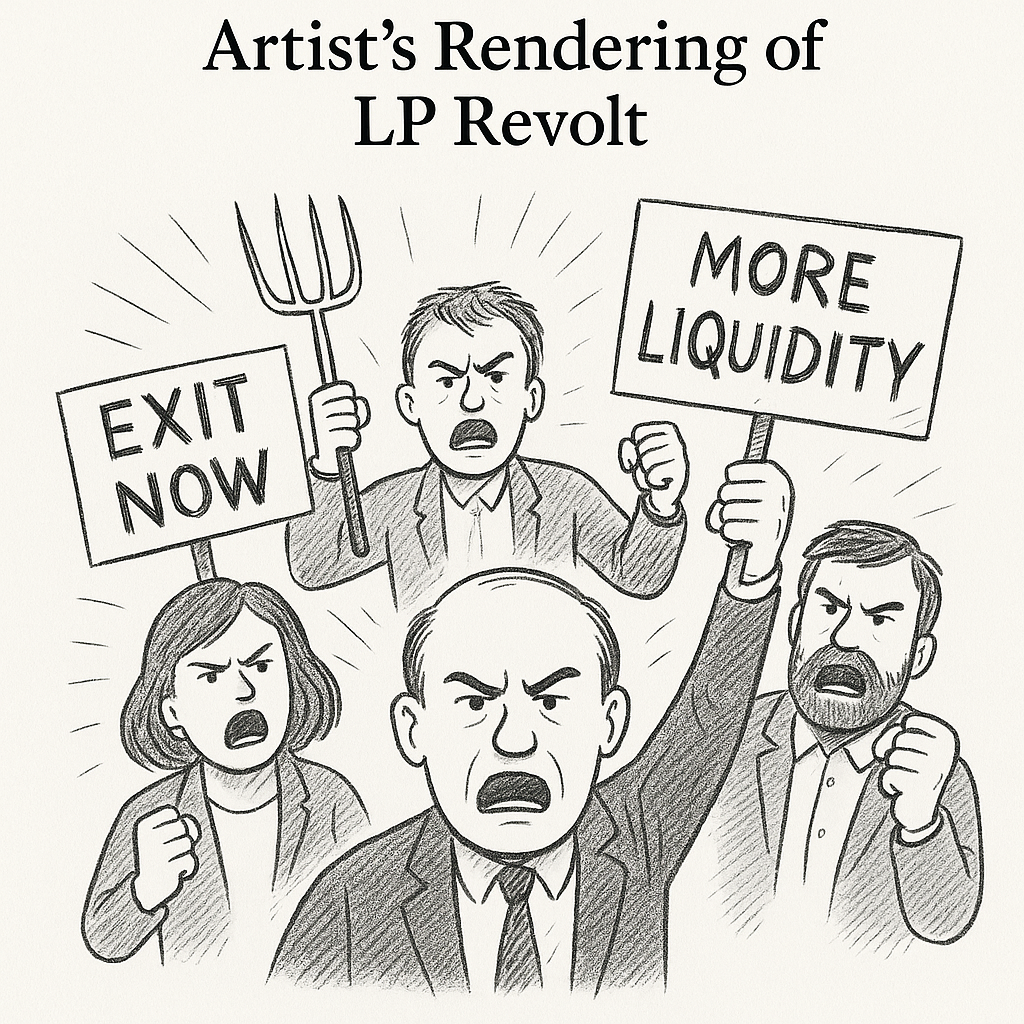A blog post from Vertical Capital Advisors with credit, where and only to the extent that arbiters and the highest court of competent jurisdiction deem us liable of expropriating theories from Stanley Bing and his seminal corporate finance masterpiece, Lloyd-What Happened: A Novel of Business.
A Memo
To: Lloyd
From: The Architect
Date: 9/16/2025
Lloyd, my friend.
Do you remember when the world was simple?
You invested in a company—call it SaaS, call it AI, call it “next-gen quantum-enabled dog food”—and two or three years later, someone rang the bell. IPO! Confetti, roadshows, a ticker symbol so shiny it made angels sing. Or, barring that, a strategic acquirer with more dollars than sense showed up, signed a term sheet, and whisked your portfolio company away to the land of liquidity.
That was then.
Now? We sit on a billion dollars of promise. A billion! A serious fund. A weighty fund. A fund with gravitas. A fund whose quarterly reports feature graphics so elegant they make LPs weep with joy. And yet, despite this abundance of presentation, something troubling lurks: The exits, Lloyd. They are gone. We once had a rhythm. Capital goes in, multiples come out. IPOs like buses—miss one, wait five minutes, there’s another. Now, buyers are “evaluating.” Translation: they are in conference rooms stroking their chins, producing PowerPoint decks with titles like “Strategic Capital Deployment Options in a Disciplined Environment.” Which is corporate dialect for “We’re not buying anything, ever.”
Instead of champagne corks popping, we find ourselves staring at the liquidity window like monks waiting for enlightenment. The IPO market, they tell me, is “cooling.” Translation: shut tight, drafty at the edges, and guarded by men with clipboards.
Strategic buyers? They circle, they sniff, they nod sagely, and then they retreat to their “capital allocation committees.” Which, if you haven’t noticed, are really just padded rooms with whiteboards where ideas go to die.
Meanwhile, the companies - our companies - keep raising, but only from insiders. We shovel good money after the already-invested money, because who else will? Outsiders are shy. “Valuations are high,” they mutter. Of course they’re high! That was the point, Lloyd.
And have you noticed the math? For every six expansion-stage investments, there’s but one lonely exit. A ratio not of abundance, but of constipation. The pipeline bulges, but the valve will not open.
Our LPs call. They ask, ever so sweetly: “When might we expect DISTRIBUTIONS?” We assure them, with the confidence of medieval astrologers, that Jupiter is in retrograde and SaaS multiples will rise again. In the meantime, please admire this waterfall chart, color-coded for your convenience.
We were told geography might help. Baltimore, they whispered. Energy deals in Houston. Health tech in DC. But exits are still hoarded by the same gilded hubs—New York, San Francisco—like dragon treasure, inaccessible to the brave yet undercapitalized knights of secondary markets.
And so we wait. Our LPs ask when distributions will come, and we smile the smile of those who do not know. We point to AI, to manufacturing, to SaaS. We say, “There is momentum.” But inside, we feel the wobble. Momentum is wonderful until you realize you’re running downhill and the brakes don’t work.
What does one do, Lloyd, when one cannot exit? One writes whimsical memos. One becomes mystical. One contemplates liquidity not as an event but as a state of being. Perhaps liquidity is enlightenment. Perhaps exits are illusions. Perhaps the true return is the friends we made along the way.
Sidebar, Lloyd. Have you noticed how the vocabulary itself betrays us?
Once, we spoke of ROI—a quaint, earthy metric. Money in, more money out. A ratio you could explain to your aunt at Thanksgiving. Ah, return on investment, wherefor art thou?
Then, in our sophistication, we ascended to MOIC. Multiple on Invested Capital. It sounded grand, didn’t it? A multiple! A multiplication! As though we were magicians. But MOIC is a mirage, Lloyd. It glows on paper, yet remains stubbornly unconverted.
And finally, the cruelest of them all: DPI. Distributions to Paid-In. Not theoretical, not pro forma, but actual, cold cash returned. And it is here, Lloyd, where the dream falters. For there are no exits, and thus no distributions.
Perhaps this progression is the curse itself: ROI begat MOIC begat DPI, and somewhere along the way the gods of liquidity grew tired of our acronyms. (See Exhibit D: Tower of Metric Babel.)
Is it the markets that have failed us, Lloyd—or simply the metrics we chose to worship?
Lloyd, perhaps the problem is not exits at all, but measurement. ROI, MOIC, DPI—these were mile markers on a road that has vanished into mist. So what comes next?
I propose HFI: Hopefulness per Fund Interval.
It measures not cash returned, nor multiples achieved, but the sheer buoyancy of spirit with which a GP explains, quarter after quarter, why liquidity is “just around the corner.”
Others may prefer LOL: Longevity of LP Patience, or perhaps the darker SIGH: Self-Inflicted GP Hand-wringing.
But HFI, Lloyd—that feels right. It captures the essence of our age: no exits, no distributions, just optimism compounded annually.
And so we enter a new spiritual phase of fund management. We meditate on liquidity. We redefine “exit” as not an event, but a state of mind. We speak of “patient capital” while somewhere, an acquirer is squinting at a data room. Somewhere, an IPO window is cracking open. Somewhere, perhaps, the great Wheel of Liquidity will turn again and Vanna will turn our magic letter.
Let us float above our billion-dollar dilemma as though we are not trapped in it, but merely observing from a higher plane. After all, it is only money.
And yet…
Lloyd. Truly.
Where did all the exits go?











